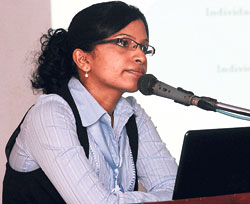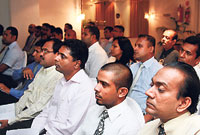Being an integral part of life, communication has become unbelievably convenient with the ever—evolving technological gizmos. For some of us, it has turned out to be a basic requirement for functioning; almost resting on the bottom level of Maslow’s Hierarchy of Needs. Try living without the mobile phone or Internet for a day and we will find out our Electronic Dependence Quotient for Communication.
Favouritism in the workplace affects productivity
 Favouritism and its impact in the workplace was the focus of an interesting discussion at the monthly meeting of the Sunday Times Business Club this week at the Taj Samudra Hotel. Favouritism and its impact in the workplace was the focus of an interesting discussion at the monthly meeting of the Sunday Times Business Club this week at the Taj Samudra Hotel.
Rozaine Cooray, CEO of Forte (a psychological consultancy) and a Business Psychologist made a presentation on this problem in relation to business psychology issues and explained the advantages and disadvantages of favouritism.
 “More often that not, it causes a lot of distress to other workers when your boss favours a particular person irrespective of whether he or she is efficient or not,” she told the members. The Taj Samudra is the club’s host hotel this year while Hameedia is a co-sponsor. “More often that not, it causes a lot of distress to other workers when your boss favours a particular person irrespective of whether he or she is efficient or not,” she told the members. The Taj Samudra is the club’s host hotel this year while Hameedia is a co-sponsor.
|
We all know it provides numerous advantages but let us take the position of a devil’s advocate. Emailing tends to make communication drag out more than it has to. People may be seated just a few yards away from us but, it is as if we cannot approach them face to face or make a brief telephone call to explain something that we think could be better expressed in the form of an email. We must be dreaming; communication is believed to comprise 7% of verbal, and 93% of non-verbal, such as body language, tone of voice and eye contact.
What we ignore mostly is not the content but this non-verbal component or the emotive tone of the message we are typing. Even some ‘politically’ correct statements can be misconstrued at the other end. What we cannot speculate when writing an email is the emotional state of mind of the recipient, when the slightest disagreement expressed can escalate into a full-blown argument.
We cannot always shift the blame on technology. If we have created it, we must also manipulate it in a way that is personal enough to be used in our interactions, be it work or otherwise – not in a destructive way.
Once a manager of a prominent organization told me how his team had been involved in an email forum on political candidates of the different political parties in the country. Seemingly an innocuous way of keeping themselves entertained at work, the debate had turned sour when one participant had strongly defended his political views by degrading others as ‘shameless fools.’ Vital points to be noted; respect for others-how aware are we that people are entitled to their opinions? Secondly, do we have to use our office e-mail to discuss issues such as these? knowing ‘what to say’, ‘where to say’, ‘how to say’ and ‘who to say’ are important elements of the ‘awareness’ that we have about the situation and the relationship with the recipients. And we all know that ‘awareness’ is crucial in personal and professional development.
Once in my career, in order to introduce a training initiative, my colleague drafted an email to our director, copying our team and all the regional managers to inform about the training schedule.
What he received in return was an alarmingly sarcastic remark from the director in a ‘reply all’ response. How come? It was self-explanatory as he had just stated some facts in plain English with two practical goals that had been discussed for weeks amongst the team members.
His initial reaction was to retort but he was too angry and left it as it was. Our team thought my director would soon figure it out but disappointingly, she did not. It took two days for someone to tell her that she had not read the email properly and that she had probably made a blunder in the eyes of all the regional managers. Then my colleague received the cleverest response from her in a personalized email; ‘come meet me’. I still think he deserved an apology though.
Learning points: We have to read the work-related emails to the last full-stop before replying. Sarcasm in emails will only make matters worse and will definitely tarnish our professional image amongst the recipients. Personal rivalries should be dealt with in person and definitely not in the most cowardly way of humiliating the recipient in a public forum. My colleague or we as a team had a part to play too; a wiser decision would have been to approach the director in person the next day to explain what was actually detailed in the email.
We probably know this by now, but just in case; amongst other best practices in email writing, are the following: We should avoid using caps; text in all caps is often interpreted as ‘yelling’. We should keep our messages short and crisp, and if we want to communicate many ideas in one email, we should use bullet points to do so. We should ask permission before we send a bulky attachment. I believe the concept of emotions is a great idea despite its confines as a replacement for real emotions and moods. Depending on our relationship with the recipients, emotions can be used to convey a serious issue on a light note. We should use ‘thank you’, ‘sorry’, ‘please’, ‘can I’ more often. As some managers I have met have stated, some of us do need to acquire some email etiquette.
We as humans, often take anything in abundance for granted. It is true that technology is becoming increasingly plentiful in our lives. However, its utility has to be respected in terms of its strengths and limitations.
Emails can never replace face to face conversations; hence whenever we can, we have to use the best option possible before drafting an email if it is necessary for future reference. We have also got accustomed to using emails to convey unpleasant messages that we have little courage to deliver in person or via a telephone call; almost similar to an ‘easy way out’.
An electronic world supports human connections. We cannot escape it; we can only make it more effective, efficient and most of all -- less destructive.
(Ms Cooray, a Business Psychologist, writes a regular column in the Business Times on issues relating to psychology issue in the workplace. In today’s commentary, she discusses email communication in the workplace which could be destructive if the right language and tone is not used and suggests more face-to-face communication.
Comments on this article are welcome to: rozaine@forte.lk or bt@sundaytimes.wnl.lk) |

 Favouritism and its impact in the workplace was the focus of an interesting discussion at the monthly meeting of the Sunday Times Business Club this week at the Taj Samudra Hotel.
Favouritism and its impact in the workplace was the focus of an interesting discussion at the monthly meeting of the Sunday Times Business Club this week at the Taj Samudra Hotel. “More often that not, it causes a lot of distress to other workers when your boss favours a particular person irrespective of whether he or she is efficient or not,” she told the members. The Taj Samudra is the club’s host hotel this year while Hameedia is a co-sponsor.
“More often that not, it causes a lot of distress to other workers when your boss favours a particular person irrespective of whether he or she is efficient or not,” she told the members. The Taj Samudra is the club’s host hotel this year while Hameedia is a co-sponsor. 